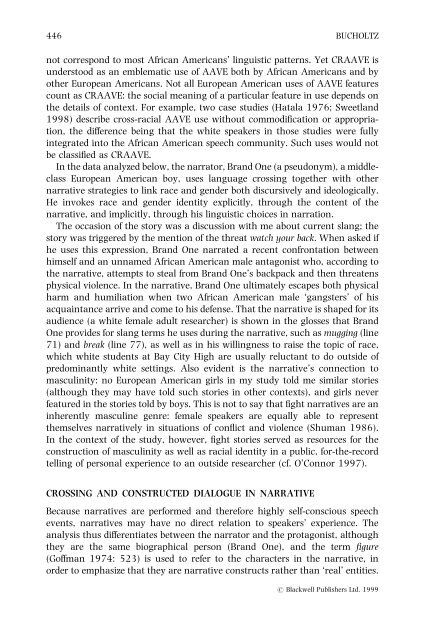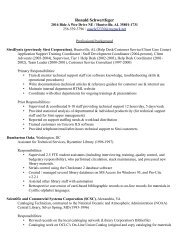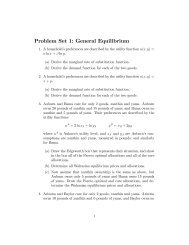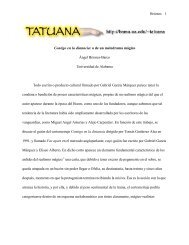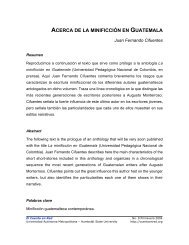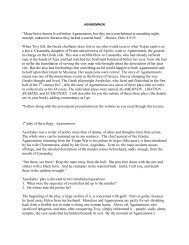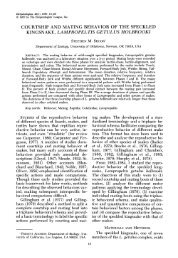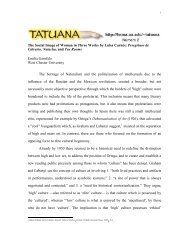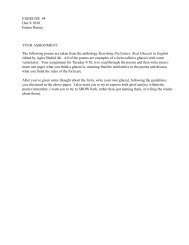You da man: Narrating the racial other in the ... - Bama.Ua.Edu
You da man: Narrating the racial other in the ... - Bama.Ua.Edu
You da man: Narrating the racial other in the ... - Bama.Ua.Edu
Create successful ePaper yourself
Turn your PDF publications into a flip-book with our unique Google optimized e-Paper software.
446<br />
BUCHOLTZ<br />
not correspond to most African Americans' l<strong>in</strong>guistic patterns. Yet CRAAVE is<br />
understood as an emblematic use of AAVE both by African Americans and by<br />
o<strong>the</strong>r European Americans. Not all European American uses of AAVE features<br />
count as CRAAVE: <strong>the</strong> social mean<strong>in</strong>g of a particular feature <strong>in</strong> use depends on<br />
<strong>the</strong> details of context. For example, two case studies (Hatala 1976; Sweetland<br />
1998) describe cross-<strong>racial</strong> AAVE use without commodi®cation or appropriation,<br />
<strong>the</strong> di€erence be<strong>in</strong>g that <strong>the</strong> white speakers <strong>in</strong> those studies were fully<br />
<strong>in</strong>tegrated <strong>in</strong>to <strong>the</strong> African American speech community. Such uses would not<br />
be classi®ed as CRAAVE.<br />
In <strong>the</strong> <strong>da</strong>ta analyzed below, <strong>the</strong> narrator, Brand One (a pseudonym), a middleclass<br />
European American boy, uses language cross<strong>in</strong>g toge<strong>the</strong>r with o<strong>the</strong>r<br />
narrative strategies to l<strong>in</strong>k race and gender both discursively and ideologically.<br />
He <strong>in</strong>vokes race and gender identity explicitly, through <strong>the</strong> content of <strong>the</strong><br />
narrative, and implicitly, through his l<strong>in</strong>guistic choices <strong>in</strong> narration.<br />
The occasion of <strong>the</strong> story was a discussion with me about current slang; <strong>the</strong><br />
story was triggered by <strong>the</strong> mention of <strong>the</strong> threat watch your back. When asked if<br />
he uses this expression, Brand One narrated a recent confrontation between<br />
himself and an unnamed African American male antagonist who, accord<strong>in</strong>g to<br />
<strong>the</strong> narrative, attempts to steal from Brand One's backpack and <strong>the</strong>n threatens<br />
physical violence. In <strong>the</strong> narrative, Brand One ultimately escapes both physical<br />
harm and humiliation when two African American male `gangsters' of his<br />
acqua<strong>in</strong>tance arrive and come to his defense. That <strong>the</strong> narrative is shaped for its<br />
audience (a white female adult researcher) is shown <strong>in</strong> <strong>the</strong> glosses that Brand<br />
One provides for slang terms he uses dur<strong>in</strong>g <strong>the</strong> narrative, such as mugg<strong>in</strong>g (l<strong>in</strong>e<br />
71) and break (l<strong>in</strong>e 77), as well as <strong>in</strong> his will<strong>in</strong>gness to raise <strong>the</strong> topic of race,<br />
which white students at Bay City High are usually reluctant to do outside of<br />
predom<strong>in</strong>antly white sett<strong>in</strong>gs. Also evident is <strong>the</strong> narrative's connection to<br />
mascul<strong>in</strong>ity: no European American girls <strong>in</strong> my study told me similar stories<br />
(although <strong>the</strong>y may have told such stories <strong>in</strong> o<strong>the</strong>r contexts), and girls never<br />
featured <strong>in</strong> <strong>the</strong> stories told by boys. This is not to say that ®ght narratives are an<br />
<strong>in</strong>herently mascul<strong>in</strong>e genre: female speakers are equally able to represent<br />
<strong>the</strong>mselves narratively <strong>in</strong> situations of con¯ict and violence (Shu<strong>man</strong> 1986).<br />
In <strong>the</strong> context of <strong>the</strong> study, however, ®ght stories served as resources for <strong>the</strong><br />
construction of mascul<strong>in</strong>ity as well as <strong>racial</strong> identity <strong>in</strong> a public, for-<strong>the</strong>-record<br />
tell<strong>in</strong>g of personal experience to an outside researcher (cf. O'Connor 1997).<br />
CROSSING AND CONSTRUCTED DIALOGUE IN NARRATIVE<br />
Because narratives are performed and <strong>the</strong>refore highly self-conscious speech<br />
events, narratives may have no direct relation to speakers' experience. The<br />
analysis thus di€erentiates between <strong>the</strong> narrator and <strong>the</strong> protagonist, although<br />
<strong>the</strong>y are <strong>the</strong> same biographical person (Brand One), and <strong>the</strong> term ®gure<br />
(Go€<strong>man</strong> 1974: 523) is used to refer to <strong>the</strong> characters <strong>in</strong> <strong>the</strong> narrative, <strong>in</strong><br />
order to emphasize that <strong>the</strong>y are narrative constructs ra<strong>the</strong>r than `real' entities.<br />
# Blackwell Publishers Ltd. 1999


